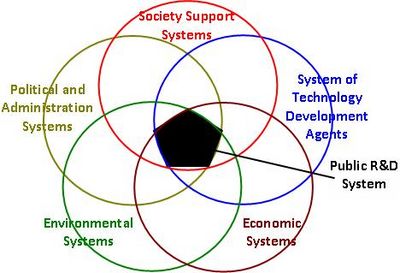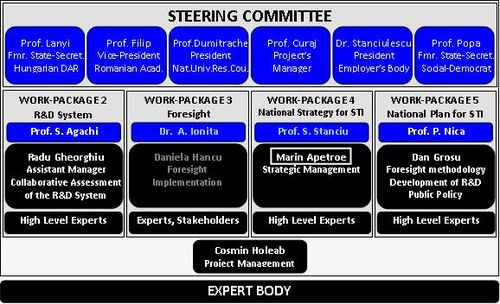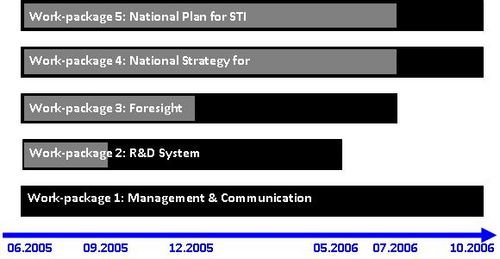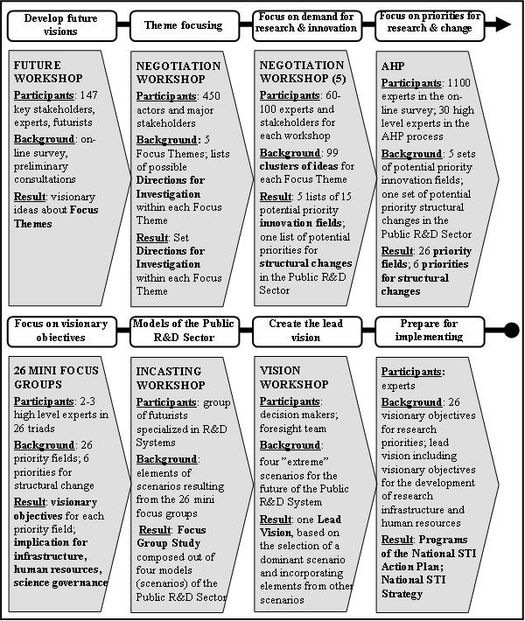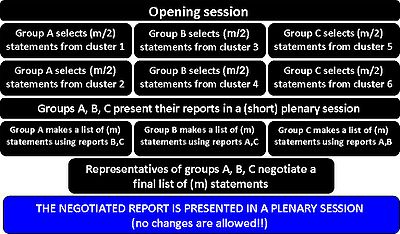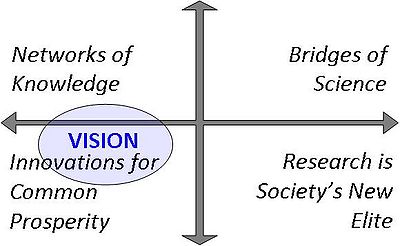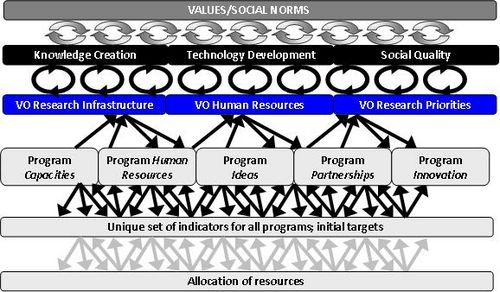Narrative: Romanian Public R&D System in 2020
From FORwiki

Background
In the early 2005, the Executive Agency for Higher Education and Research Funding from Romania was entrusted with the task of developing a new National Strategy for Research, Development, and Innovation, as well as a new National Action Plan for Research, Development, and Innovation during the years 2007 - 2013. Preliminary evaluations of the first National Plan for RDI, which had just been concluded, indicated that results were not always satisfactory, especially when it came to distinguishing a distinct raise in competitiveness for Romanian manufactured products and services as a result of public funds being invested in RDI. At the same time, Romania was influenced by a process of "Europeanization" - adopting new ways and means for developing public policy - during its ascension to full membership in the European Union. The decision to run a national foresight exercise was thus circumscribed to Romanian policy-makers' effort to move towards more inclusive, collaborative, and future-oriented ways to develop public policies for the R&D sector.
However, an important number of national strategies were developed prior to the foresight exercise, covering almost every system within the Romanian society, and most often including long-term priorities for research and development. The foresight exercise was not meant to invalidate these strategies. All the contrary its role was to preserve homeostasis within the Public R&D System, and to provide mechanisms for dynamic equilibria adjustment and regulation. In other words, the objective was not to identify "the best" set of long-term priorities for research, but to provide a negotiated equilibrium between distinct, and sometimes competing visions about the future.
Management structure
The project's management structure reflects the general theme of equilibrium and negotiation that dominated the foresight process. One particularity is that the Steering Committee was, in effect, the main decision body, holding weekly meetings for the most part of the project's duration. Its' members were high-level decision-makers, representing the main political parties, as well as confederate unions and the ownership of R&D facilities. The prospective outcome of the foresight exercise, and the promise that it will set the parameters for public policy in the R&D sector for a long time period of time, charged politically the foresight process from its very beginning. (Figure 2) Under these circumstances, the involvement of external experts in foresight was very limited.
The project's financial support was secured by the National Authority for Scientific Research.
Figure 2: The project's management structure (Steering Committee, Foresight Team, Expert Body), and Gantt chart
Foresight design
The source of inspiration for foresight design was the first German Futur process. Its evaluation by a team of independent experts was completed not long before the Romanian foresight exercise had begun. Results were encouraging and, further more, the Futur process (renamed "The German Funnel" by Romanian futurists) was holding the promise of producing Lead Visions that are translatable into public policy. Moreover, the Futur process was doing this in an open and inclusive manner, and this was very important for the Romanian project (Figure 3).
But translating a narrative of German foresight into a Romanian context is much like transforming a Grimm Brothers' fairytale into a story about Dracula! Collaborative assessment of long-term challenges and opportunities took second stage, and became no more than a supporting argument in negotiation. There was no place for fluffy images in a Romanian lead vision for research and development. Romanian stories about the future look more like a metallic universe, dripping with the blood and sweat of a frontier people.
The Romanian narrative was also influenced by systems thinking.
Read more about Systems Thinking for Foresight.
Participation
Diversity in participation was an essential feature of the foresight process. After all, the purpose was to have all interested parties involved in the negotiation process. Representatives of agents from a variety of societal systems participated in one or several stages of the foresight process. However, a distinction needs to be made. While activities which involved "direct negotiations", such as the Negotiation Workshops or the Vision Workshop, were geared more towards decision-makers, expertise was a perquisite for participation in other activities. Still, assuring variety in participants' affiliations was pursued with obstinacy by the foresight team.
Mapping the stakeholders, and a nomination/co-nomination process were involved. Participants to the foresight process, both decision-makers and experts, were selected from the following categories:
- Agents of the Technology Development System
- Public Administration
- Business Agents
- Civic Society
Step 1: Develop future visions
- Key stakeholders were interviewed in order to determine possible Focus Themes for the foresight exercise.
- A Future Workshop was organized. The objective was to determine a set of Focus Themes from the data collected during the interviews. The participants were decision-makers and futurists. Five Focus Themes were identified:
- Information Society Technologies
- Competitiveness through Innovation
- Quality of Life
- Social and Cultural Dynamics
- Energy and Environment
- A "non-thematic" Focus Theme was added. It's topic was structural change in the Public R&D System.
- An online survey was used in order to collect data on possible Directions for Investigation within each Focus Theme.
- The data were clustered, and initial lists of possible Directions for Investigation were produced for each Focus Theme.
Step 2: Theme focusing
The final set of Directions for Investigation were selected from the larger set. Each Focus Theme had to have at least a minimal number of Directions for Investigation. A Negotiation Workshop was organized, with participants representing the system of technology development agents, economic systems, environmental systems, political and administration systems, social support systems. They formed groups and negotiated according to their interest in one or another of the Focus Themes, rather than the above mentioned affiliations.
|
The Negotiation Workshop Objective: Select m statements, balanced among p categories, from a larger set of n visionary statements Preliminaries: A large number of statements about the future are collected, grouped and merged into n visionary statements; the n visionary statements are further grouped into p clusters. Participants: 60-100 people, representing a diversity of actors (research system, public administration, private interests, civic society, …). Script:
|
Step 3: Focus on the demand for scientific research, and technology development
- Once the Directions for Investigation were set, data about Romania's long-term research priorities within each Direction for Investigation were collected through interviews and an online survey.
- The data were merged into 99 visionary statements for each Focus Theme.
- The 99 visionary statements were grouped in 6 clusters for each Focus Theme.
- A Negotiation Workshop was organized for each Focus Theme. The workshops produced lists of 15 potential priority visionary statements.
Step 4: Focus on priorities for research, innovation, and structural change
This step in the foresight process involved a collaborative approach to Multiple Criteria Analysis. The objective was to select high-priority Fields of Innovation from the first five lists of visionary statements. Separately, a high-level expert group selected high-priority Structural Changes for the Public R&D System, from the sixth list (see Table 2).
Literature on MCDM (Multiple Criteria Decision Methods) indicated that they hold their promise in terms of lending both rigor and transparency to the foresight process. More important, the problem of balance in technological grouping was crucial for the Romanian methodology, and a Multiple Criteria Analysis seemed to address this problem. Innovation studies had shown that a “critical” technology often depends on advances on other technologies, which might be perceived as less “critical” in the beginning. Hence, identifying priority Fields of Innovation was not to be done by isolating and ranking them, but rather by examining portfolios of innovation fields, promoted in conjunction.
Among the multiple criteria decision methods used in foresight exercises, the Romanian team chose to employ AHP (Analytical Hierarchy Process) for two important reasons: (1) it is easy to understand by all participants involved; (2) software support was available. And then the six steps of the method were implemented.
- Identification of stakeholders: Over 1000 experts eventually took part in an on-line voting procedure on the innovation fields that were to become governmental spending priorities. Participation was balanced against the criteria of affiliation to one of the following categories: technology developers, public administration, private sector, civil society.
- Development of goals: A Futures Workshop was dedicated to building a consensus about the goals of Romanian technology research and innovation among the most influential stakeholders (representatives of the Romanian government, managers of successful industrial enterprises). The one-day workshop took place in a remote location (that reminded the participants of some of the most infamous characters in Romanian history!), and, in the end, three long-term goals emerged: Development of Knowledge, Achieving Technological Competitiveness, and Raising Social Quality.
- Model development: A focus group was organized with decision-makers from the System of Technology Development Agents, and the three goals further differentiated into seven lower-level criteria against which the innovation fields were to be evaluated:
- C1: “has the potential to raise the overall economic competitiveness in Romania”;
- C2: “results in the creation of jobs”;
- C3: “will raise social cohesion”;
- C4: “will improve the environmental quality of Romania”;
- C5: “is attractive for private investors in technology development and innovation”;
- C6: “develops knowledge”;
- C7: “Romanian innovation system will produce results before 2020”.
- Score elicitation: Participants to a on-line voting procedure were invited to rate innovation fields against the low-level criteria.
- Weight elicitation: Criteria weights were elicited to assess the relative importance of the criteria, in accordance with the AHP method. A small group of high level experts produced pair-evaluations on the relative importance of criteria for each Focus Theme. The data were then processed using dedicated software.
- Computation of overall performance measures: Results from score and weight elicitation were combined to derive an aggregate value for each innovation field. This value ranks alternatives according to their desirability relative to the others, but it does not provide a definitive answer. Experts were asked to pick a balanced portfolio of best-ranked alternatives for each of the Focus Themes. Only then this stage in foresight exercise was completed.
Table 1 illustrates the selected portfolio of high-priority Fields of Innovation for each Focus Theme.
| INFORMATION SOCIETY TECHNOLOGIES |
|
| COMPETITIVENESS THROUGH INNOVATION |
|
| QUALITY OF LIFE |
|
| SOCIAL AND CULTURAL DYNAMICS |
|
| ENERGY AND ENVIRONMENT |
|
| STRUCTURAL CHANGE IN THE PUBLIC R&D SYSTEM |
|
Step 5: Focus on visionary objectives
A mini-focus group was organized for each one of the twenty-six Fields of Innovation. The participants - authoritative experts in the respective fields - were asked to address the following topics:
- Offer visionary ideas about desirable long-term objectives for this Field of Innovation.
- Propose a desirable thematic for research on the long-term.
- Specify ways in which the structural changes previously identified are desirable for this Field of Innovation.
- Provide insights on the implication for the development of research infrastructures and human resources, and also for the science governance model.
Step 6: Models for the public R&D sector
A scenario workshop was organized. A set of definitions for extreme futures were provided (see below). Participants - mostly decision-makers and futurists - were asked to use the data collected during the focus group research to describe the impact of such futures on the following issues:
- development of research infrastructure
- development of human resources
- preferred science governance model
|
Incasting Scenario Method Goal: Elaborate fixed, multiple scenarios Characteristics:
Method Participants, possibly divided into small groups, read a paragraph that describes a rather extreme version of an alternative future. The topics used in the Romanian foresight were the following:
Participants are asked to describe the impact of such futures on a series of issues. |
Step 7: Create a lead vision
A "vision workshop" was organized with the participation of high-level decision-makers. The scenario Innovation for Common Prosperity was selected as a dominant scenario. Elements of the scenario Networks of Knowledge were incorporated, to create a Lead Vision for the Public R&D System. The vision describes in narrative form a desirable future, approaching issues related to the development of research infrastructures and human resources. A model for science governance is proposed.
Step 8: Prepare for implementing
The final step in the foresight process was dedicated to preparations for implementing the results. Consultations were held with high ranking officials of the National Agency for Scientific Research, and with other high-level decision makers. But most of the work was done by experts in developing R&D public policies, as well as futurists. The task was to create internal mechanisms for funding, evaluation, research priority adjustment, impact assessment, and others that would be consistent with the radical change proposed by the visionary objectives
Visionary objectives for Fields of Innovation were particularized for the interval of time between the years 2007 and 2013, and were used to develop requirements for the programme Partnerships. The Lead Vision provided visionary objectives for developing research infrastructures and human resources. They were further particularized in the requirements for the programmes Human Resources, and Capacities. Two more programmes were created: Ideas (dedicated to basic research), and Innovations (dedicated to exploratory, "out of the box" innovative thinking). Together, these five programmes formed the National Action Plan for Research, Development, and Innovation.
In the first months of 2007, the National Action Plan for Research, Development, and Innovation was adopted by the Romanian Government, and was passed as legislation.
Outcomes
The results of the foresight exercise were charged with high levels of legitimacy. Widely regarded as a negotiated compromise about the future of Public R&D Sector, the results were accepted by both Academia and Polity. They do not claim to describe "the best possible future", but rather "the most desirable future". And we mean desirable for agents from most distinct systems within Romanian society.
But the Romanian foresight process also brought to the forefront of a national dialogue on science and technology twenty-six Fields of Innovation. Results of research in four of these fields sky-rocketed during the foresight process, and ever since.
- Advanced Information Systems for e-Services
- Advanced Materials
- Quality of Health
- Sustainable Energy Systems and Technologies. Energetic Security
Is this an outcome of the foresight process? Did the foresight process function as a catalyst for creating networks of innovators? There is no evidence for something like that, and the answer is most likely negative. What happened is that the foresight process pinpointed positive evolutions and phenomena which were already there. And this is its most important outcome.
Lessons learned
The foresight process was focused on the part of the Public R&D System that is involved in applied research. However, Romanian futurists learned very fast that one cannot disrupt part of the system without disrupting the whole system. A parallel stream had to be organised, in which dialogue on the future of basic research was hosted. And even though there was little interaction between the two, this secondary stream also proved to be important. A good lesson to have in mind for future foresight exercises!
External links
- Project's homepage (romanian)
- Systemic Foresight
- Infinite Futures
